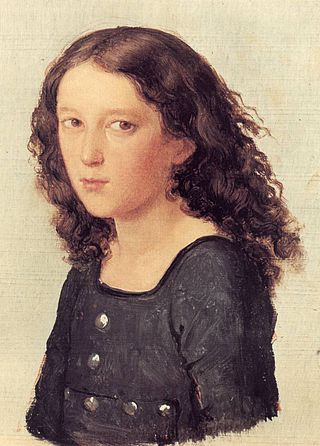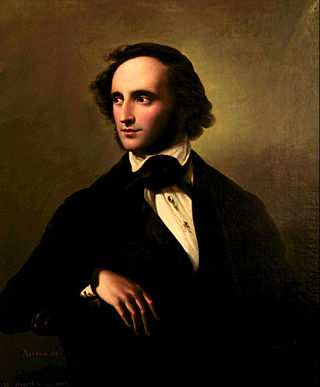Structure
The composition has three movements:
- Allegro vivace
- Adagio
- Assai vivace
A typical performance lasts roughly 22 minutes.
The Violin Sonata (No. 3) in F major, MWV Q 26, was composed in 1838 by Felix Mendelssohn, but remained unpublished during the composer's lifetime. It remained so until 1953 when violinist Yehudi Menuhin arranged it for publication. [1]
Mendelssohn began work on the Violin Sonata in 1838, the same year he started work on the Violin Concerto in E minor. By the 15th of June 1838 he had completed the composition in draft form, but rejected the work as a "wretched sonata". [a] [3]
It was not until 1839 that Mendelssohn began work on revising the sonata by rewriting the first movement. [3] However the task remained uncompleted at his death in 1847 and it was not until 1953, that violinist Yehudi Menuhin revived the work and prepared it for publication by revising the first movement based on Mendelssohn's incomplete revision. [3] [2]
The composition has three movements:
A typical performance lasts roughly 22 minutes.

Felix Mendelssohn's Violin Concerto in E minor, Op. 64, MWV O 14, is his last concerto. Well received at its premiere, it has remained among the most prominent and highly-regarded violin concertos. It holds a central place in the violin repertoire and has developed a reputation as an essential concerto for all aspiring concert violinists to master, and usually one of the first Romantic era concertos they learn. A typical performance lasts just under half an hour.

The Symphony No. 5 in D major/D minor, Op. 107, known as the Reformation, was composed by Felix Mendelssohn in 1830 in honor of the 300th anniversary of the Presentation of the Augsburg Confession. The Confession is a key document of Lutheranism and its Presentation to Emperor Charles V in June 1530 was a momentous event of the Protestant Reformation. This symphony was written for a full orchestra and was Mendelssohn's second extended symphony. It was not published until 1868, 21 years after the composer's death – hence its numbering as '5'. Although the symphony is not very frequently performed, it is better known today than when it was originally published. Mendelssohn's sister, Fanny Mendelssohn Hensel, chose the name Reformation Symphony.

The sonatas and partitas for solo violin are a set of six works composed by Johann Sebastian Bach. They are sometimes referred to in English as the sonatas and partias for solo violin in accordance with Bach's headings in the autograph manuscript: "Partia" was commonly used in German-speaking regions during Bach's time, whereas the Italian "partita" was introduced to this set in the 1879 Bach Gesellschaft edition, having become standard by that time. The set consists of three sonatas da chiesa in four movements and three partitas in dance-form movements. The 2nd Partita is widely known for its Chaconne, considered one of the most masterful and expressive works ever written for solo violin.
The Symphony in C major by German composer Robert Schumann was published in 1847 as his Symphony No. 2, Op. 61, although it was the third symphony he had completed, counting the B-flat major symphony published as No. 1 in 1841, and the original version of his D minor symphony of 1841. It is dedicated to Oscar I, king of Sweden and Norway.

The Symphony No. 3 in A minor, Op. 56, MWV N 18, known as the Scottish, is a symphony by Felix Mendelssohn, composed between 1829 and 1842.

Robert Schumann's Violin Concerto in D minor, WoO 1, written in 1853, was his only violin concerto and one of his last significant compositions. It remained unknown to all but a very small circle for more than 80 years after it was written.

The Concerto for Violin and String Orchestra in D minor, MWV O 3, was composed by Felix Mendelssohn at the age of thirteen. It has three movements, Allegro–Andante–Allegro, and performance duration is approximately 22 minutes.
The Sonata for Solo Violin Sz. 117, BB 124, is a sonata for unaccompanied violin composed by Béla Bartók. It was premiered by Yehudi Menuhin, to whom it was dedicated, in New York on 26 November 1944.

The String Quartet No. 6 in F minor, Op. 80 was composed by Felix Mendelssohn in 1847. It was the last major piece he completed before he died two months later, on 4 November 1847. It is believed he composed the piece as an homage to his sister Fanny, who died on 14 May of that year.
The String Quartet No. 2 in A minor, Op. 13, was composed by Felix Mendelssohn in 1827. Written when he was 18 years old, it was, despite its official number, Mendelssohn's first mature string quartet. One of Mendelssohn's most passionate works, the A minor Quartet is one of the earliest and most significant examples of cyclic form in music.
The String Quartet No. 5 in E-flat major, Op. 44, No. 3, was composed by Felix Mendelssohn in 1837–1838 and completed on February 6, 1838. The piece is part of the Op. 44 set of 3 string quartets that Mendelssohn dedicated to the Crown Prince of Sweden.

Felix Mendelssohn's Piano Trio No. 1 in D minor, Op. 49, was completed on 23 September 1839 and published the following year. The work is scored for a standard piano trio consisting of violin, cello and piano. It is one of Mendelssohn's most popular chamber works and is recognized as one of his greatest along with his Octet, Op. 20. During the initial composition of the work, Mendelssohn took the advice of fellow composer Ferdinand Hiller to revise the piano part. Hiller wrote, "with his usual conscientious earnestness when once he had made up his mind, he undertook the length and rewrite the whole pianoforte part."
Felix Mendelssohn's Sextet in D major, Op. 110, MWV Q 16, for piano, violin, two violas, cello, and double bass was composed in April–May 1824, when Mendelssohn was only 15, the same time he was working on a comic opera Die Hochzeit des Camacho. Its composition took place between the Viola Sonata and the Piano Quartet No. 3. It also preceded the famous Octet, Op. 20 by about a year. 1824 is also the probable year of the composition of the Clarinet Sonata. Like the latter, the Sextet was not published during the composer's lifetime. Its first edition was issued in 1868 as a part of a complete collection of Mendelssohn's works, hence the misleadingly high opus number.
Felix Mendelssohn's Cello Sonata No. 1 in B-flat major, Op. 45 was composed in October 1838.
Felix Mendelssohn's Cello Sonata No. 2 in D major, Op. 58, was composed in late 1842 — first half of 1843. The main theme of the first movement is a reworking of an unrealised Piano Sonata in G major. The Cello Sonata, which was dedicated to the Russian/Polish cellist Count Mateusz Wielhorski, has four movements:

Felix Mendelssohn's six Organ Sonatas, Opus 65, were published in 1845. Mendelssohn's biographer Eric Werner has written of them: "Next to Bach's works, Mendelssohn's Organ Sonatas belong to the required repertory of all organists."

The six sonatas for violin and obbligato harpsichord BWV 1014–1019 by Johann Sebastian Bach are works in trio sonata form, with the two upper parts in the harpsichord and violin over a bass line supplied by the harpsichord and an optional viola da gamba. Unlike baroque sonatas for solo instrument and continuo, where the realisation of the figured bass was left to the discretion of the performer, the keyboard part in the sonatas was almost entirely specified by Bach. They were probably mostly composed during Bach's final years in Cöthen between 1720 and 1723, before he moved to Leipzig. The extant sources for the collection span the whole of Bach's period in Leipzig, during which time he continued to make changes to the score.

The Concerto for Piano, Violin, and Strings in D minor, MWV O4, also known as the Double Concerto in D minor, was written in 1823 by Felix Mendelssohn when he was 14 years old. This piece is Mendelssohn's fourth work for a solo instrument with orchestral accompaniment, preceded by a Largo and Allegro in D minor for Piano and Strings MWV O1, the Piano Concerto in A Minor MWV O2, and the Violin Concerto in D minor MWV O3. Mendelssohn composed the work to be performed for a private concert on May 25, 1823 at the Mendelssohn home in Berlin with his violin teacher and friend, Eduard Rietz. Following this private performance, Mendelssohn revised the scoring, adding winds and timpani and is possibly the first work in which Mendelssohn used winds and timpani in a large work. A public performance was given on July 3, 1823 at the Berlin Schauspielhaus. Like the A minor piano concerto (1822), it remained unpublished during Mendelssohn's lifetime and it wasn't until 1999 when a critical edition of the piece was available.